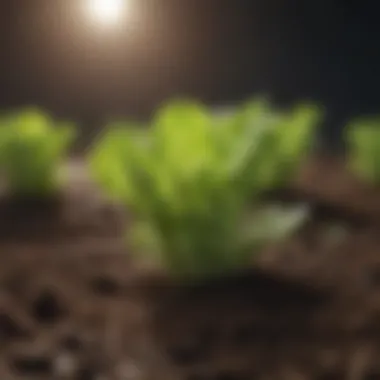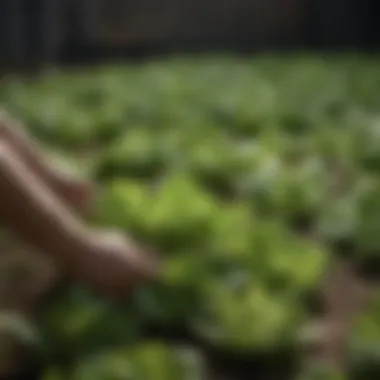Unlocking the Secrets of Lettuce Planting Season: A Detailed Guide


Gardening Know-How
Lettuce, a versatile and nutritious leafy green, thrives best when planted during the cool seasons of spring and fall. This comprehensive guide aims to equip gardening enthusiasts with the knowledge and techniques necessary to yield a bountiful lettuce harvest. Beginning with the crucial aspect of choosing the right lettuce variety for your garden, factors such as leaf shape, color, and growth habits play a pivotal role in determining success. Understanding the ideal planting times based on your local climate and frost dates is essential in establishing a robust crop.
Selecting the Perfect Spot for Planting
For lettuce to flourish, providing it with adequate sunlight is paramount. Opt for a location that receives partial shade during the hottest part of the day, ensuring that the delicate leaves do not wither under intense sunlight. Furthermore, the soil quality is a crucial determinant of lettuce growth. Loamy, well-draining soil enriched with organic matter promotes root development and nutrient absorption, leading to healthy plants.
Soil Preparation and Maintenance
Before sowing your lettuce seeds, prepare the soil by loosening it to a depth of at least six inches to facilitate root expansion. Incorporating compost or aged manure enhances soil fertility, providing a nutrient-rich environment for your lettuce to thrive. Remember to maintain consistent soil moisture levels throughout the growing season, as lettuce has shallow roots and is sensitive to both drought and water-logging.
Cultivation Techniques for Optimal Growth
Implementing proper spacing between lettuce plants is crucial for adequate air circulation and preventing overcrowding. Thin out seedlings as they grow to ensure sufficient room for each plant to reach its full potential. Regularly monitor for pests and diseases, opting for organic pest control methods to safeguard your lettuce crop while maintaining environmental sustainability.
By following these expert insights and techniques, you can embark on a journey to cultivate luscious lettuce in your own garden, enriching your culinary endeavors with the freshest home-grown produce.
Understanding Lettuce Planting Season
Understanding the intricate nuances of lettuce planting season is paramount for any avid gardener seeking to optimize their harvest yields. This section serves as a cornerstone in the comprehensive guide to lettuce cultivation, shedding light on key factors that influence the optimal growth of lettuce plants. By delving into the climatic variations, varietal selection, and local frost dates, individuals can make informed decisions that will elevate their gardening experience to new heights.
Factors Influencing Lettuce Planting Season
Climate Variations
Climate variations play a pivotal role in determining the success of lettuce cultivation. Understanding the specific climate requirements tailored to lettuce plants is crucial for ensuring their vigorous growth and development. By discerning the unique characteristics of different climate variations and their impact on overall plant health, gardeners can align their planting strategies effectively. Embracing the advantages of suitable climate conditions enhances the chances of a bountiful lettuce harvest.
Varietal Selection
Selecting the right lettuce varieties is a critical aspect of lettuce planting season. Certain lettuce varieties thrive in particular growing conditions, making it essential to choose varieties that are well-suited to the local environment. By highlighting the key characteristics of different lettuce varieties and their suitability for varied gardening scenarios, individuals can make informed choices that optimize plant health and productivity.
Local Frost Dates


Local frost dates exert a significant influence on lettuce planting season, shaping the timelines for planting and harvesting lettuce crops. Being aware of the local frost dates is essential for planning planting schedules and protecting tender lettuce plants from potential frost damage. Understanding the unique features of local frost dates and their implications for lettuce cultivation empowers gardeners to make timely decisions that safeguard their harvests.
Optimal Planting Times
Early Spring Planting
Embarking on early spring plantings sets the stage for a flourishing lettuce garden. The key characteristic of early spring planting lies in capitalizing on the cool, moist conditions that lettuce plants thrive in. By exploring the unique features of early spring planting and understanding its advantages and potential challenges, gardeners can kickstart their lettuce cultivation journey with confidence.
Late Summer Planting
Late summer planting presents an opportune time to extend the lettuce growing season. The key characteristic of late summer planting is leveraging the waning heat of summer to nurture lettuce plants to maturity. By delving into the unique features of late summer planting and weighing its advantages and disadvantages, individuals can make informed choices regarding their planting schedules.
Fall Planting Tips
Implementing fall planting tips is essential for maintaining lettuce production into the cooler months. The key characteristic of fall planting tips is adapting cultivation practices to suit the changing seasonal conditions. By examining the unique features of fall planting tips and considering their benefits and potential drawbacks, gardeners can ensure a continuous supply of fresh lettuce throughout the autumn period.
Soil Preparation for Lettuce
Importance of Well-Draining Soil
Well-draining soil is a fundamental requirement for successful lettuce cultivation. The key characteristic of well-draining soil lies in its ability to prevent waterlogging, which can impede plant growth. By elucidating the unique features of well-draining soil and showcasing its advantages and limitations, individuals can create optimal growing conditions that promote robust lettuce growth.
Nutrient Requirements
Meeting the nutrient requirements of lettuce plants is essential for fostering healthy growth and development. Understanding the key nutrients that lettuce plants need and how to provide them facilitates nutrient-rich soil environments. By exploring the unique features of nutrient requirements and evaluating their pros and cons, gardeners can establish nutrient-balanced soil compositions that bolster lettuce health.
Composting Techniques
Effective composting techniques are instrumental in enhancing soil fertility for lettuce cultivation. The key characteristic of composting techniques is their ability to enrich the soil with organic matter, promoting nutrient uptake in lettuce plants. Delving into the unique features of composting techniques and assessing their advantages and disadvantages enables gardeners to implement sustainable practices that amplify soil quality for optimal lettuce growth.
Seed Selection and Germination
Hybrid vs. Heirloom Seeds


Choosing between hybrid and heirloom seeds is a pivotal decision in lettuce cultivation. The key characteristic of hybrid vs. heirloom seeds lies in their genetic compositions and breeding histories. By dissecting the unique features of hybrid and heirloom seeds and analyzing their respective benefits and drawbacks, gardeners can select seeds that align with their cultivation goals and preferences.
Indoor Germination Steps
Mastering indoor germination steps is essential for jumpstarting the lettuce growing process. The key characteristic of indoor germination steps is providing controlled environments for optimal seed germination. By outlining the unique features of indoor germination steps and weighing their advantages and disadvantages, individuals can cultivate sturdy seedlings that are primed for successful transplanting.
Direct Sowing Guidelines
Following direct sowing guidelines aids in promoting robust lettuce growth from seed to harvest. The key characteristic of direct sowing guidelines lies in establishing proper planting depths and spacings for seed distribution. By elucidating the unique features of direct sowing guidelines and deliberating on their advantages and limitations, gardeners can execute precise sowing practices that foster healthy lettuce stands.
Caring for Lettuce Plants
Caring for lettuce plants is a crucial aspect that demands attention in the process of growing lettuce. Ensuring the well-being and optimal conditions for your lettuce plants can significantly impact the yield and quality of your harvest. Watering and irrigation practices, pest and disease management, pruning, and harvesting techniques all fall under the umbrella of caring for lettuce plants. By understanding the specific needs of lettuce plants and implementing appropriate care, you can nurture thriving and healthy crops. Taking the time and effort to care for your lettuce plants will pay off in the form of bountiful and flavorful harvests.
Watering and Irrigation Practices
Watering and irrigation practices play a vital role in the success of lettuce cultivation. One of the key components of caring for lettuce plants is maintaining proper watering frequency. Adequate hydration is essential for the growth and development of lettuce plants, ensuring they receive the necessary nutrients for healthy expansion. Drip irrigation offers specific benefits in lettuce cultivation by delivering water directly to the plants' roots, promoting efficient water usage and reducing moisture-related diseases. Foliage moisture management is another critical aspect to consider, as excessive moisture on leaves can lead to fungal infections and rot. By carefully managing the moisture levels around the foliage, you can prevent common issues and maintain the overall health of your lettuce plants.
Proper Watering Frequency
Proper watering frequency is essential for sustaining the growth and vitality of lettuce plants. By watering consistently but without over-saturation, you can support the plants' root systems and nutrient uptake. The key characteristic of proper watering frequency lies in finding the balance between hydration and avoiding waterlogging, ensuring that the plants thrive without being water-stressed. This approach is a popular choice among gardening enthusiasts for its ability to sustain plant health and enhance crop productivity. Proper watering frequency provides a stable water supply to the plants, allowing for steady growth and optimal nutrient absorption. Despite its advantages, improper watering frequency can lead to root rot, wilting, and nutrient deficiencies, emphasizing the importance of mastering this practice in lettuce cultivation.
Drip Irrigation Benefits
Drip irrigation offers numerous benefits in lettuce cultivation by delivering water efficiently and precisely to the plants' root zones. The key characteristic of drip irrigation lies in its ability to minimize water wastage and ensure targeted hydration for optimal plant growth. This method is a popular choice for this article due to its effectiveness in conserving water resources and reducing the risk of foliage diseases caused by excessive moisture. The unique feature of drip irrigation is its capacity to provide a controlled and consistent water supply to each plant, promoting healthier root development and minimizing weeds. While drip irrigation offers substantial advantages in water conservation and plant health, some disadvantages include initial setup costs and the need for regular maintenance to prevent clogging or system malfunctions.
Foliage Moisture Management
Foliage moisture management is essential for preserving the health and vigor of lettuce plants. By regulating the moisture levels around the foliage, you can prevent issues such as fungal infections, mildew, and bacterial diseases. The key characteristic of foliage moisture management is its impact on reducing the risk of pest infestations and diseases that thrive in humid conditions. This practice is a beneficial choice for this article as it contributes to maintaining the overall well-being of lettuce plants and sustaining a productive growing environment. The unique feature of foliage moisture management is its role in promoting air circulation around the leaves, preventing excessive dampness that can attract pathogens. While effective moisture management can enhance plant immunity and vigor, improper handling may lead to leaf discoloration, mold growth, and decreased photosynthetic efficiency.
Advanced Tips and Troubleshooting
As we journey into the advanced realm of lettuce cultivation, the emphasis shifts towards honing our expertise in troubleshooting and maneuvering through potential challenges. This section serves as a beacon of guidance for seasoned gardeners and enthusiasts alike. By delving into intricate details and strategic maneuvers, we pave the way for a more profound understanding of lettuce cultivation.


Season Extension Methods
Row Covers and Cold Frames
When exploring the realm of season extension methods for lettuce planting, the utilization of row covers and cold frames emerges as a pivotal strategy. These protective covers shield delicate lettuce plants from harsh weather conditions and extend the growing season. The insulating properties of row covers and cold frames create a microclimate conducive to optimal lettuce growth, ensuring a bountiful harvest. While these tools provide invaluable protection, careful monitoring is essential to prevent overheating during warmer days.
Greenhouse Cultivation
Greenhouse cultivation stands as a cornerstone of season extension, offering a controlled environment for lettuce growth. The key advantage lies in providing a sheltered space that shields plants from adverse weather and promotes consistent growth. Greenhouses enable year-round cultivation, empowering growers to bypass seasonal constraints and nurture lettuce in a stable microclimate. However, efficient ventilation and temperature regulation are imperative to prevent humidity buildup and disease outbreaks within this enclosed setting.
Succession Planting Strategies
To maximize lettuce production throughout the year, succession planting strategies play a crucial role in maintaining a continuous harvest. By staggering planting dates, growers ensure a steady supply of fresh lettuce by sowing new crops as others reach maturity. This method optimizes space utilization and prevents gluts in harvest, fostering a sustainable and consistent lettuce supply. However, meticulous planning and attention to timing are paramount to achieve a seamless transition between successive plantings.
Common Lettuce Growing Challenges
Bolting Prevention
One of the primary challenges in lettuce cultivation is preventing bolting, the premature onset of flowering triggered by stress factors. Bolting disrupts leaf development and diminishes the quality of lettuce crops, underscoring the importance of vigilant monitoring and preventative measures. By providing adequate water, sheltering plants from extreme heat, and selecting bolt-resistant varieties, growers can mitigate the risk of bolting and ensure robust lettuce growth.
Tipburn Management
Tipburn, characterized by browning and necrosis at leaf margins, presents a common issue in lettuce cultivation linked to calcium deficiencies and water imbalances. Effective tipburn management involves maintaining consistent moisture levels, supplementing with calcium-rich fertilizers, and regulating irrigation practices. By addressing these underlying factors, growers can safeguard their lettuce crops and promote optimal leaf development.
Nutrient Deficiency Signs
Nutrient deficiencies pose a significant challenge in lettuce cultivation, manifesting through symptoms like yellowing leaves, stunted growth, and poor plant vitality. Identifying and addressing these deficiencies through soil testing, balanced fertilization, and micronutrient supplementation is critical to supporting healthy lettuce growth. By fortifying the soil with essential nutrients, growers can prevent deficiencies and cultivate vibrant, nutrient-rich lettuce crops.
Lettuce Companion Planting
Beneficial Plant Pairings
In the realm of companion planting, selecting beneficial plant pairings enhances the growth and resilience of lettuce crops. Companion plants like herbs, legumes, and flowers contribute to biodiversity, deter pests, and improve soil health through mutualistic relationships. By strategically interplanting lettuce with compatible companions, growers can enhance overall garden productivity and create a harmonious ecosystem that nurtures plant growth.
Companion Planting Chart
A companion planting chart serves as a valuable resource for planning and implementing diverse plant combinations in the garden. This visual guide outlines compatible plant pairings, detailing synergistic relationships that promote growth and deter pests. By referencing a companion planting chart, growers can optimize plant placement, capitalize on companion planting benefits, and design well-balanced garden ecosystems that support lettuce and its companion plants.
Natural Pest Repellents
Harnessing the power of natural pest repellents offers an eco-friendly approach to pest management in lettuce cultivation. Plants like marigolds, chives, and mint act as natural repellents, deterring common pests and safeguarding lettuce crops from infestations. Integrating these natural pest repellents into companion plantings creates a protective barrier around lettuce, fostering a pest-resistant environment that promotes plant health and vigor.







